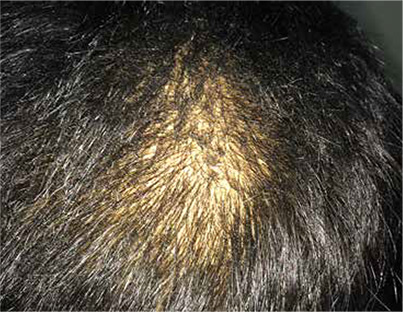Acquired trichorrhexis nodosa
Keywords:
Trichorrhexis nodosa, hair disease, hair shaftAbstract
Acquired trichorrhexis nodosa is a rarely reported hair disorder, but it is likely to be a common disorder. It is characterized by keratin alterations of the hair cuticle shaft which produces increased hair fragility to chemical or physical injuries and generates some clinical features as frayed, brittle or dry hair, with shortened growth and whitish nodules on the hair shaft, which help in the suspected diagnosis. Light microscopy and trichoscopy show typical images of incomplete fracture of the hair shaft that look like two brushes facing each other. The treatment is to avoid these traumas, and use of hair conditioners and vitamins, because there is no specific treatment.
Author Biographies
Jairo Hernán Rodríguez
Médico, residente de segundo año de Dermatología, Escuela de Dermatología y Cirugía Dermatológica, Departamento de Medicina Interna, Facultad de Salud, Universidad del Valle, Cali, Colombia.
Claudia Juliana Díaz
Médica dermatóloga; docente, Escuela de Dermatología y Cirugía Dermatológica, Departamento de Medicina Interna, Facultad de Salud, Universidad del Valle, Cali, Colombia.
References
2. Leonard C. Sperling “alopecias”. En: Bolognia JL, Jorizzo JL, Rapini RP, editors. Dermatology. Second edition. London: Mosby; 2008. p. 1003.
3. Kharkar V, Gutte R, Thakkar V, Khopkar U. Trichorrhexis nodosa with nail dystrophy: Diagnosis by dermoscopy. Int J Trichology. 2011;3:105-6.
4. Fichtel JC, Richards JA, Davis LS. Trichorrhexis nodosa secondary to argininosuccinicaciduria. Pediatr Dermatol. 2007;24:25-7.
5. Neuser F, Schlatter H. Hair dyes. En: Draelos ZD, editor. Cosmetic dermatology: Products and procedures. Oxford: Wiley-Blackwell; 2010. p. 256-310.
6. Rudnicka L, Rakowska A, Kerzeja M, Olszewska M. Hair shafts in trichoscopy: Clues for diagnosis of hair and scalp diseases. Dermatol Clin. 2013;31:695-708.
7. Sisto T, Bussoletti C, D’Amore A, Favoriti N, Fania L, Celleno L. Inability to grow long hair: A presentation of trichorrhexis nodosa. Cutis. 2015;95:15-6.
8. Bolduc C, Shapiro J. Hair care products: Waving, straightening, conditioning, and coloring. Clin Dermatol. 2001;19:431-6.
9. Dawber R. Hair: Its structure and response to cosmetic preparations. Clin Dermatol. 1996;14:105-12.
How to Cite
Downloads

Downloads
Published
How to Cite
Issue
Section
| Article metrics | |
|---|---|
| Abstract views | |
| Galley vies | |
| PDF Views | |
| HTML views | |
| Other views | |






